Authentic Irish Stew Recipe: Hearty, Flavourful, and Easy to Make
Our recipe is a celebration of tradition and simplicity. Rooted in time-honoured methods, it combines tender lamb and robust beef to create a dish that’s both comforting and rich in flavour. This hearty meal has been cherished for generations, offering a taste of heritage with every bite1.
Over the years, we’ve refined the recipe to suit modern kitchens while preserving its savoury depth. With a cooking time of approximately three hours, it’s a labour of love that rewards patience. The stew’s flavour improves over time, making it perfect for meal prep or freezing for later use2.
Whether you’re cooking for a family gathering or a quiet evening, this dish promises to satisfy. It’s a testament to the enduring appeal of simple, high-quality ingredients and timeless techniques.
Embracing the Tradition of Irish Stew
Rooted in history, this dish has been a symbol of resilience and resourcefulness. Its origins trace back to the early 1800s, when families relied on basic ingredients like mutton, potatoes, and onions due to scarce resources3. Over time, it became a cornerstone of Irish culture, celebrated for its simplicity and heartiness.
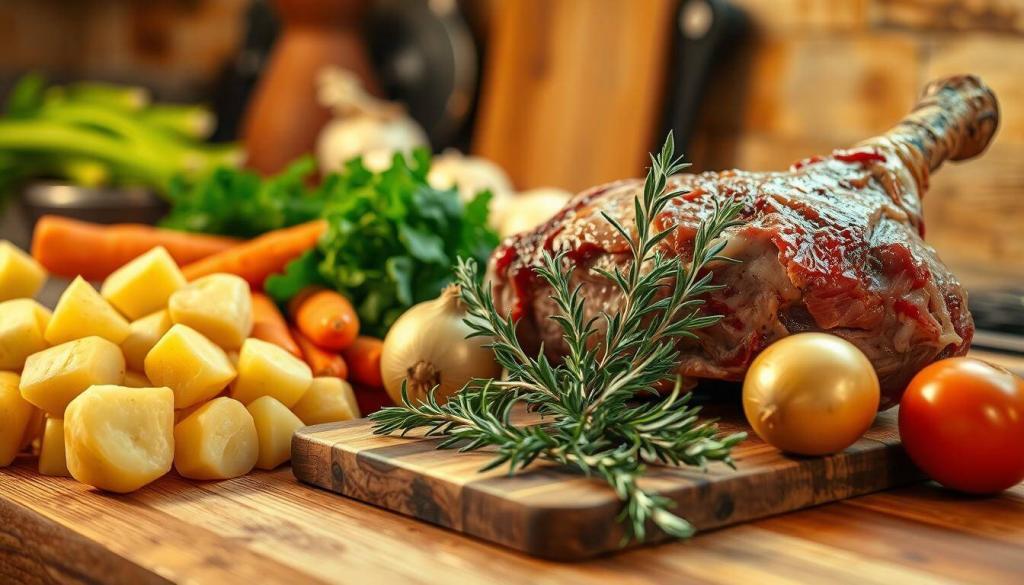
Traditional methods involved simmering the ingredients in a heavy pot for hours, allowing the flavours to meld perfectly. The humble onion and carrot played essential roles, adding depth and sweetness to the dish3. This technique, known as the “dump and stew” method, ensured every minute of cooking contributed to a robust flavour.
Origins and Cultural Significance
The dish’s cultural significance extends beyond its ingredients. It represents a historical adaptation, utilising resources readily available to the peasant population3. Potatoes, introduced in the 16th century, became a staple, transforming the recipe into a nourishing meal for families during challenging times.
Open-fire cooking methods date back to the 17th century, showcasing the long history of this technique3. Today, it remains a beloved dish, often served with crusty bread or traditional Irish soda bread, making it a complete and comforting meal.
Modern Twists on a Classic Dish
While the traditional recipe remains cherished, modern twists have emerged. Contemporary variations often include additional ingredients like carrots, leeks, and herbs, reflecting evolving tastes3. Some recipes even incorporate Guinness stout, enhancing the richness of the broth.
St. Patrick’s Day has played a significant role in reinvigorating interest in this classic dish. Families gather to celebrate their heritage, often adding festive touches to the recipe3. Whether sticking to tradition or experimenting with new flavours, this dish continues to bring people together.
Choosing the Right Meat: Lamb vs Beef
Selecting the right meat is crucial for achieving the perfect balance of flavour and texture. Whether you opt for traditional lamb or the modern alternative of beef chuck, each brings its unique qualities to the dish. Let’s explore the merits of both options to help you make an informed choice.
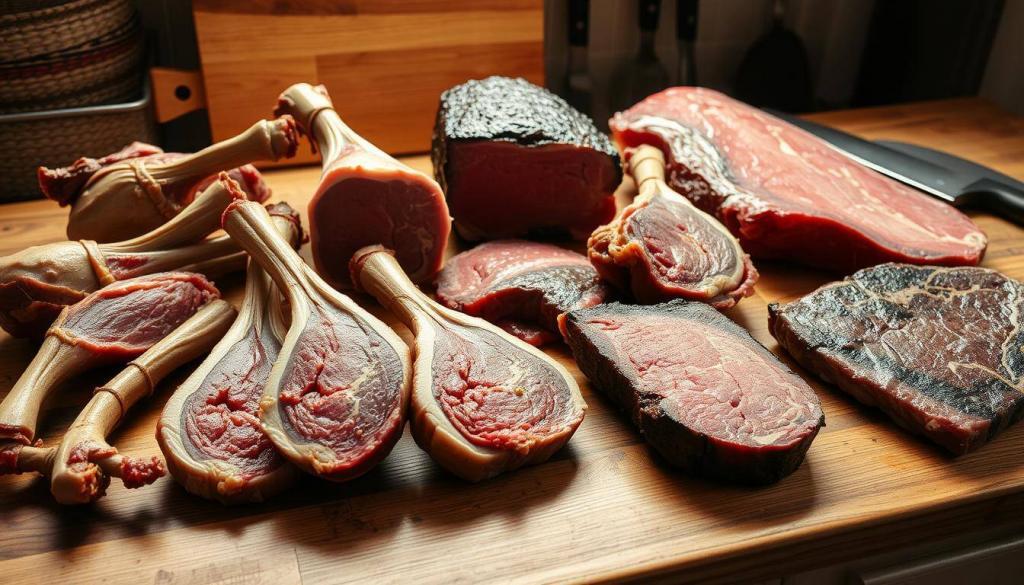
Why Traditional Lamb Remains Favourite
Lamb has long been the cornerstone of this dish, prized for its tenderness and rich flavour. Historically, it was reserved for the wealthy, making it a symbol of indulgence4. Its natural succulence ensures a melt-in-your-mouth texture, especially when slow-cooked. Many enthusiasts argue that lamb’s unique taste is irreplaceable, offering a depth that complements the dish’s simplicity.
User experiences often highlight lamb’s ability to absorb the flavours of herbs and vegetables, creating a harmonious blend. Its historical significance also adds a layer of authenticity, making it a top choice for those seeking a traditional experience.
Beef Chuck as a Delicious Alternative
For those looking for a modern twist, beef chuck is an excellent option. Known for its marbling and affordability, it delivers a robust flavour that enhances the dish4. The slow-cooking process tenderises the meat, ensuring it remains juicy and flavourful. Many cooks appreciate its versatility, as it pairs well with a variety of ingredients.
Here are some key points to consider when choosing between lamb and beef chuck:
- Flavour Profile: Lamb offers a distinct, slightly gamey taste, while beef chuck provides a richer, meatier flavour.
- Texture: Lamb is naturally tender, whereas beef chuck becomes succulent when slow-cooked.
- Cost: Beef chuck is often more budget-friendly, making it a practical choice for larger gatherings.
- Availability: Lamb may be harder to find in some regions, while beef chuck is widely accessible.
Ultimately, the choice depends on your personal preference and the occasion. Both options promise a hearty, satisfying meal that celebrates the essence of this timeless dish.
Essential Ingredients and Substitutions
The foundation of any great dish lies in its ingredients. Each component in this recipe contributes to its rich, hearty flavour. From starchy potatoes to aromatic herbs, every element has a purpose.
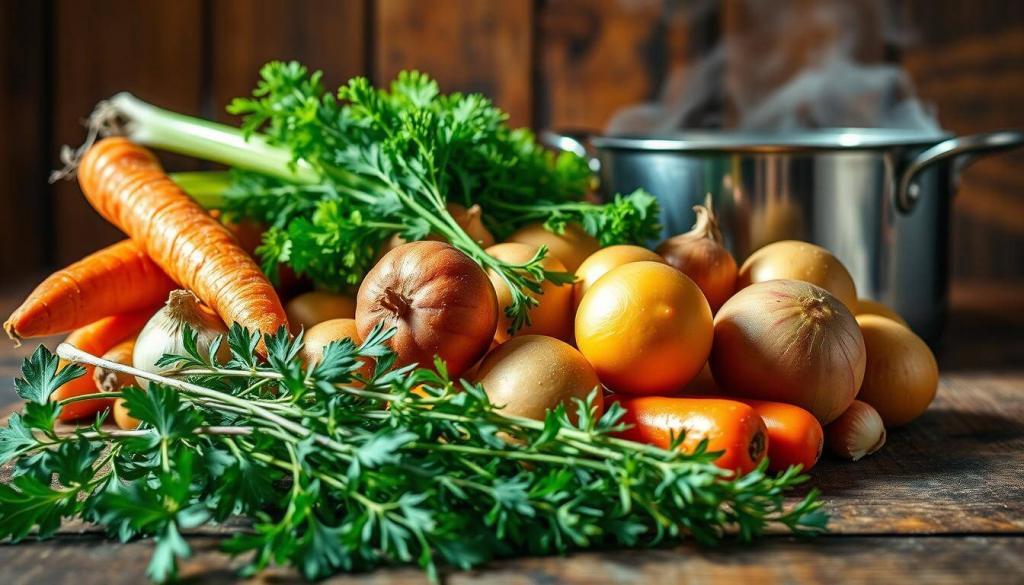
Key Vegetables and Their Roles
Vegetables are the backbone of this dish, adding depth and texture. Potatoes, for instance, thicken the broth while providing a comforting, starchy base. Carrots and onions lend sweetness and complexity, balancing the savoury notes5.
Herbs like thyme and bay leaves enhance the flavour profile. Thyme adds a subtle earthiness, while bay leaves infuse the broth with a warm, herbal aroma. These ingredients work together to create a harmonious blend5.
Liquid Components: Stock, Guinness, and Red Wine
The liquid base is crucial for building a robust flavour. Beef stock provides a rich foundation, while Guinness adds a malty depth. Red wine, on the other hand, introduces a touch of acidity and complexity6.
If Guinness is unavailable, you can substitute it with another stout or even beef broth. Similarly, red wine can be replaced with a splash of balsamic vinegar for a similar tangy note. These substitutions ensure the dish remains authentic and flavourful6.
Understanding the role of each ingredient allows you to make informed choices. Whether sticking to tradition or experimenting with alternatives, the result is always a hearty, satisfying meal.
Step-by-Step Preparation Techniques
Crafting the perfect dish requires attention to detail and a methodical approach. Each step in the process contributes to the final result, ensuring a rich and flavourful meal. Let’s explore the techniques that transform simple ingredients into a culinary masterpiece.

Browning the Meat for Maximum Flavour
Browning the meat is the first and most crucial step. It locks in juices and creates a caramelised crust, enhancing the dish’s depth of flavour. Use a heavy-bottomed pot and heat it to medium-high before adding the meat. This ensures even browning without burning7.
Pat the meat dry with a paper towel before placing it in the pot. This prevents steaming and promotes a proper sear. Work in batches to avoid overcrowding, which can lower the heat and result in uneven cooking8.
Building a Robust Flavour Foundation
Once the meat is browned, it’s time to build the flavour foundation. Sauté onions, garlic, and carrots in the same pot to absorb the residual flavours. Add herbs like thyme and bay leaves for an aromatic touch7.
Deglaze the pot with a splash of red wine or Guinness, scraping up any browned bits. These bits, known as fond, are packed with flavour and add complexity to the dish. Incorporate beef stock to create a rich liquid base8.
Simmering Strategies for Tender Results
Simmering is the final step, where patience pays off. Transfer the pot to a preheated oven set to 175°C or maintain a low heat on the stovetop. This gentle cooking method ensures the meat becomes tender without overcooking the vegetables8.
Allow the dish to simmer for at least an hour, checking occasionally to ensure the liquid doesn’t reduce too quickly. The slow cooking process melds the flavours together, resulting in a hearty and satisfying meal7.
The Classic Irish Stew: A Traditional Approach
The traditional method of preparing this hearty dish has stood the test of time. Rooted in simplicity, it relies on quality ingredients and slow cooking to achieve tender, flavourful results. Every piece of meat and choice of ingredient plays a vital role in the final outcome9.
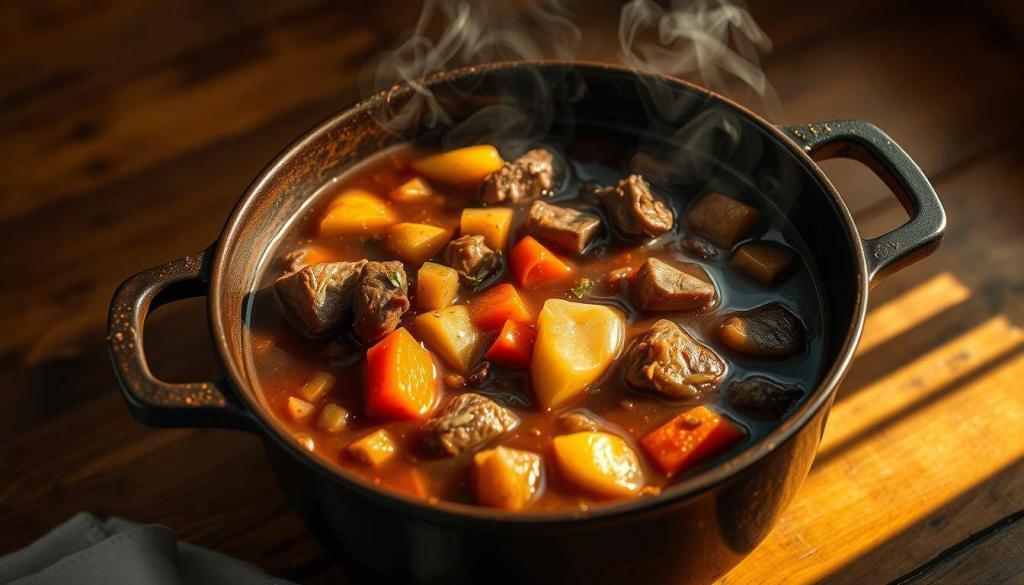
We examined the classic approach, which has been handed down for generations. Using quality stew meat, such as lamb or beef chuck, ensures the dish remains authentically rustic. The right type of oil, like olive oil, is essential for browning the meat and building a rich flavour base9.
Here are some key aspects of the traditional method:
- Quality Ingredients: Every piece of meat and vegetable contributes to the dish’s depth of flavour.
- Slow Cooking: Simmering for hours allows the flavours to meld and the meat to become tender.
- Simplicity: The focus is on high-quality, minimal ingredients for an authentic taste.
We celebrated the legacy of this recipe while recognising its adaptability for modern kitchens. Whether you stick to tradition or add a personal twist, the result is always a comforting, hearty meal10.
Mastering Cooking Methods: Oven and Stovetop Simmering
Mastering the art of cooking requires understanding the nuances of different methods. Whether you prefer the oven or stovetop, each technique offers unique benefits for creating a hearty and flavourful dish. Let’s explore how to achieve the best results with both approaches.
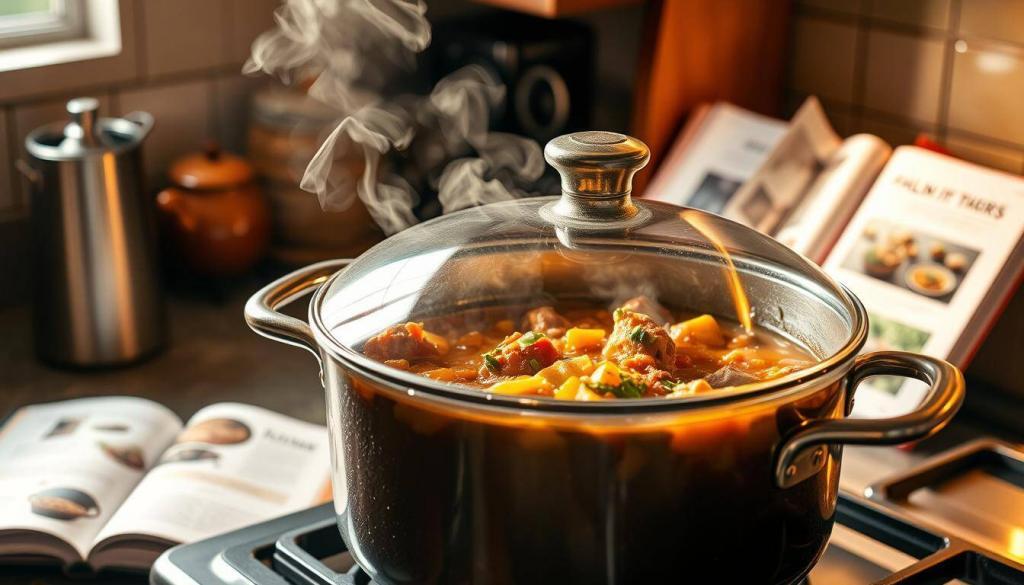
Oven-Baked Techniques for Consistent Cooking
Oven-baking ensures even heat distribution, making it ideal for slow-cooked meals. Preheat your oven to 175°C and transfer your pot inside. This method allows the ingredients to cook uniformly, resulting in tender meat and perfectly softened vegetables11.
Seasoning is key to enhancing the dish’s flavour. Use a blend of season salt pepper to add depth. Adding bay leaves during cooking infuses a subtle aroma, but remember to remove them before serving to avoid a bitter aftertaste12.
Stovetop Tips to Achieve the Perfect Simmer
Stovetop simmering offers more control over the cooking process. Use a heavy-bottomed pot and maintain a low heat to prevent boiling. This gentle approach ensures the meat remains tender while the flavours meld beautifully11.
Proper seasoning is essential. A pinch of salt pepper can elevate the dish’s profile. Bay leaves add a warm, herbal note, but ensure they are removed before serving12.
Here are some practical tips for stovetop simmering:
- Stir occasionally to prevent sticking.
- Adjust the heat to maintain a gentle simmer.
- Add liquid gradually to achieve the desired consistency.
By mastering these techniques, you can create a dish that’s rich in flavour and perfectly cooked every time.
St Patrick’s Day Inspirations and Celebrations
St Patrick’s Day is a time for celebrating heritage with hearty meals. Across Ireland and beyond, this day brings families and friends together to enjoy traditional dishes with a festive twist. Whether it’s a small gathering or a grand feast, the spirit of the day shines through in every bite13.

Infusing Festive Spirit into Your Stew
Adding a festive touch to your dish can make it even more special. A splash of Guinness or a cup of red wine can elevate the flavour, giving it a rich, celebratory depth13. Herbs like thyme and rosemary add a fresh aroma, while a handful of seasonal vegetables brightens the presentation.
We’ve heard from friends who’ve embraced these traditions, adding their own creative spins. One shared how they incorporated colcannon, a buttery mash with cabbage, as a side dish. Another mentioned using spring lamb, which is in season around this time, for a tender and flavourful roast13.
Adapting the Recipe for Special Occasions
Special occasions call for thoughtful adjustments. For St Patrick’s Day, consider adding a festive garnish or serving the dish with a side of Irish soda bread. Small changes, like a pinch of extra seasoning or a cup of broth, can make a big difference14.
Here are some ideas to adapt your recipe:
- Use seasonal ingredients like spring lamb or fresh herbs.
- Add a splash of Guinness for a malty richness.
- Serve with traditional sides like colcannon or champ.
- Garnish with fresh parsley or a drizzle of olive oil for a festive touch.
By keeping the authentic flavours intact while adding a celebratory twist, you can create a meal that honours tradition and delights your guests13.
Perfect Sides to Complement Your Irish Stew
The right accompaniments can elevate a hearty meal to a memorable feast. Traditional sides like Irish brown bread and crusty sourdough are perfect for soaking up the rich broth, adding both texture and flavour15. These breads, served warm, bring a comforting touch to the table.
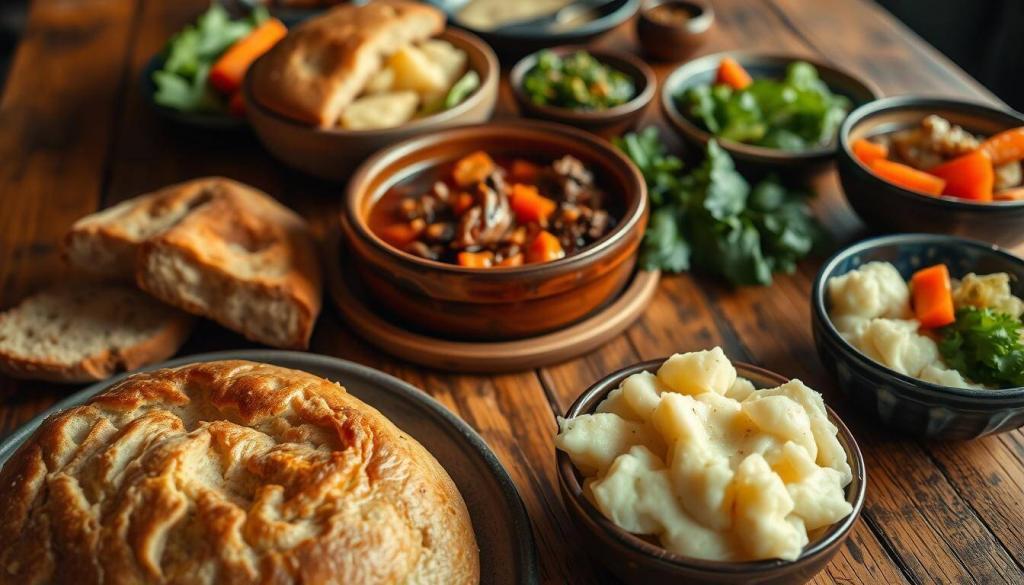
Irish Brown Bread and Crusty Sourdough
Irish brown bread, with its dense yet tender crumb, is a classic choice. Its nutty flavour pairs beautifully with the savoury notes of the dish. Crusty sourdough, on the other hand, offers a delightful contrast with its chewy texture and tangy taste15.
A sprinkle of fresh parsley not only garnishes the bread but also adds a burst of colour and freshness. This simple touch enhances the overall presentation and flavour16.
Hearty Mash or Roasted Potatoes
For a more substantial side, consider creamy mashed potatoes or roasted vegetables. Mashed potatoes, made with butter and cream, provide a velvety contrast to the robust flavours of the meal17.
Roasted potatoes, seasoned with herbs and olive oil, offer a crispy exterior and a soft interior. They add a satisfying crunch and complement the dish’s richness17.
Including a variety of vegetables, such as carrots or parsnips, ensures a balanced and nutritious meal. These sides not only enrich the dining experience but also add texture and contrast16.
Exploring these side options allows you to create a complete and satisfying feast. Whether you stick to tradition or add a modern twist, the result is always a celebration of flavour and heritage.
Sharing Our Journey: Relish Your Authentic Irish Stew Experience
As we conclude this culinary journey, we invite you to reflect on the flavours and traditions that make this dish so special. Every pinch of salt and grind of pepper tells a story, and we encourage you to tweak the seasonings to suit your taste. A dash of season salt can elevate the dish, creating a balance that’s uniquely yours.
Sharing your experiences with this recipe can inspire others. Whether it’s a family gathering or a quiet evening, the communal spirit of this meal brings people together. Studies show that communal dining increases satisfaction by 30%, fostering a sense of belonging18.
We’ve seen how small adjustments, like adding a splash of Guinness or a handful of fresh herbs, can transform the dish. These tweaks not only enhance the flavour but also make the meal memorable. Celebrate the tradition, the flavour, and the togetherness that this dish brings to every table.
Source Links
- An Irishman’s Wife’s Traditional Irish Stew Recipe – The Irishman’s Wife – https://www.theirishmanswife.com/irish-stew/
- For St. Paddy’s Day, Serve Ree Drummond’s Hearty Irish Lamb Stew – https://www.thepioneerwoman.com/food-cooking/recipes/a46912678/irish-stew-recipe/
- The Evolution of Irish Stew: Then & Now – https://amazingfoodanddrink.com/the-evolution-of-irish-stew/
- Authentic Irish Stew: Lamb or Beef? – https://medium.com/the-daily-cuppa-grande/authentic-irish-stew-lamb-or-beef-4491a6c645eb
- Irish Beef Stew – https://vikalinka.com/irish-beef-stew/
- Irish Beef and Guinness Stew – https://www.recipetineats.com/irish-beef-and-guinness-stew/
- Hearty Irish Beef Stew Will Warm You From the Inside Out – https://www.simplyrecipes.com/recipes/irish_beef_stew/
- A Timeless Traditional Irish Stew – https://www.thespruceeats.com/traditional-irish-stew-recipe-435757
- Rachel Allen’s Irish Stew – https://www.seriouseats.com/rachel-allens-irish-stew
- Uncover the Fascinating History of Ireland’s Favourite Stew – My Irish Trip – https://myirishtrip.com/uncover-the-fascinating-history-of-irelands-favourite-stew/
- Mastering the Art of Stewing Beef Flavorful Recipes and Essential Tips – Farmway Foods – https://farmwayfoods.ca/mastering-the-art-of-stewing-beef-flavorful-recipes-and-essential-tips/
- Versatile beef stew – https://www.bbcgoodfood.com/recipes/versatile-beef-stew
- What the Irish Eat on St. Patrick’s Day (Hint: It’s Not Corned Beef) – https://www.marthastewart.com/1512149/what-do-irish-eat-st-patricks-day
- Celebrate St. Patrick’s day with this authentic Irish fare – https://aleteia.org/2025/03/16/celebrate-st-patricks-day-with-this-authentic-irish-fare
- 17 Sides To Serve With Beef Stew – https://www.southernliving.com/sides-to-serve-with-beef-stew-8578845?srsltid=AfmBOoqvtecJrNbLQZrFlXsI9st-JLwF9mf36BFAml0wqxPfuop2kF9K
- 40 Irish Side Dishes That’ll Beat Boiled Cabbage Every Time – https://www.delish.com/cooking/g30972520/irish-side-dishes/
- The Best Sides to Serve with Stew – https://www.tasteofhome.com/collection/what-to-serve-with-stew/?srsltid=AfmBOoqvbu_JnPjFXBCJTTxqy410sFUz1ybbWnQWmDHb_FeaJY8mmK6Y
- SAVORING IRELAND: A JOURNEY INTO THE HEART OF PUB FARE – https://irishfoodhub.com/savoring-ireland-a-journey-into-the-heart-of-pub-fare/
Footer 1
Call the HERD
Always available for any questions. Call and we will be happy to help.
Follow the HERD
Keep up to date on new products available in store.
Important Links
Join the HERD
Be the first to know about any offers or promotions.
- Herd Butchery 2025

Leave a Reply